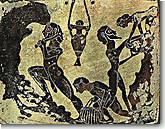





     |
|
| |
| |
The roots of the associations called koinoniai chrematon can be traced to kinship and religious forms of organization, such as the syssitoi and orgeones. Solon gave them the right to draw up their own constitution, for which simply the endorsement of the members was required. A sine qua non for it to be in force was that it did not go against the standing laws. From their foundation onwards, the associations acquired competence in law for all acts that did not require the status of a natural entity. They also had competence as contractors (ekleptoria) vis-a-vis the city, in mining and trading operations and in other public works. |  |
|
| |
|
Note: Click on a picture for a brief description. | |